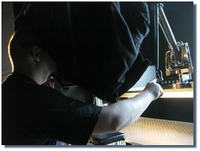Phantom lab
|
In the Phantom Lab we are able to experiment in a virtual environment. In this virtual environment, we can present both visual and haptic three-dimensional stimuli and, above all, investigate how perception works when information from both sensory modalities is available. The visual stimuli are generated by special 3D glasses. With these glasses, either the left or the right lens is alternately closed 120 times per second. This closing mechanism is synchronised with the monitor, which can display a total of 120 images per second. This means that we are able to present different images - or more precisely, slightly offset images in perspective - for the left eye and the right eye. The frequency of 60 Hz per eye is so high that the opening and closing of the lens is not noticed. Due to the different perspective of the two monitor images, a realistic three-dimensional scene is perceived. At the same time, the index finger is attached to a small holder on the phantom in such a way that it can move freely within a certain range. The associated computer now continuously measures the finger position and then displays a representation of the index finger tip (e.g. symbolised by a simple dot) in real time on the monitor, also in three dimensions. The phantom can also actively change the finger position through forces generated by the computer or prevent the finger from moving further in a certain direction. For example, objects can be defined whose surface can be felt three-dimensionally because you can move freely everywhere else but feel resistance at the surface of the object and movement into or through the object is not possible. The same object can also be visually represented in three dimensions as described above. A special mirror construction ensures that the object is visually located exactly where it is also felt haptically. With regard to different perceptual tasks, we measure different perceptual performances in a typical experiment using psychophysical methods, independently of each other in a purely visual condition and in a purely haptic condition. This could be, for example, the discrimination threshold, i.e. the question of the smallest perceptible difference in size between 2 objects. From the perceptual performances of both modalities, we then make specific predictions as to how an optimal system would integrate the individual pieces of information into an overall judgement. And we then compare these predictions with the actual measured performance when both perceptual modalities are available at the same time.
|
   |
The following publications are examples of research results from this laboratory:
|
